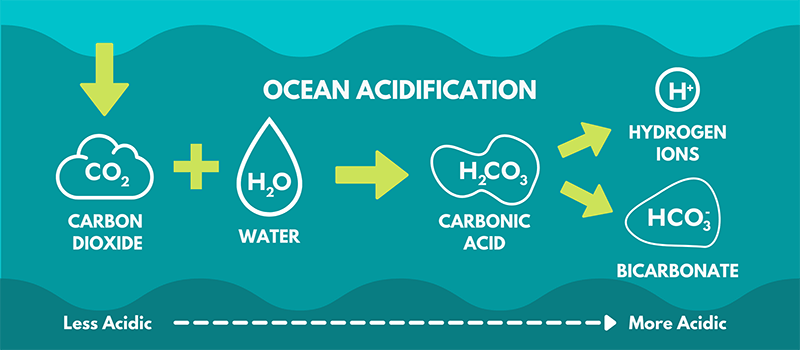
Credit: Yale Office of Sustainability
Ocean acidification is a phenomenon where the acidity of the water in the ocean increases. Because of human-driven increased levels of carbon dioxide in the atmosphere, there is more CO2 dissolving into the ocean. This has created carbonic acid lowering the oceanic pH levels which in turn makes the ocean more acidic.
Thus, the issues of climate change and ocean acidification directly correlate; the more carbon dioxide is released into the atmosphere, the more the acid levels of the ocean will rise. Ocean acidification is expected to have negative overall effects on many marine species. This could alter marine food chains and food supply to humans[1].
Due to this correlation, the mitigation responses to treat acidification tend to focus more on limiting CO2 emissions and limiting or reducing the amount of carbon dioxide in the atmosphere [2].
Robotic Solutions for Ocean Acidification
- Scientists at the University of California, San Diego, [3] have developed tiny robots that could remove carbon dioxide from the oceans, helping to mitigate the effects of climate change. Each tiny tube-shaped robot, measuring six micrometers long, is entirely autonomous, so they can be deployed into the water and left to their own devices.
- In an effort to increase the amount of information about the ocean in general, Liquid Robotics, a subsidiary of The Boeing Company that focuses on developing marine technology, has developed the Wave Glider: a marine robot that sits on the surface of the water and can collect ocean data for up to a year. The Wave Glider can also deploy a winch to collect data at a depth, as well, such as subsea acoustics, water sampling, and fish tracking.
- Similar to Liquid Robotics, Openoceanrobotics USVs (Uncrewed or Unmanned Surface Vehicles) are also equipped with sensors, cameras, and communication devices so that they can capture information from anywhere on the ocean and have instant access to it. Harvesting energy from the sun, these boats travel nonstop for months, without producing any greenhouse gas emissions, noise pollution, or risk of oil spills. These boats can monitor oil spills, detect intentional dumping, and aid in the cleanup effort.
To see ongoing research and development for monitoring and/or mitigating ocean acidification, click here.
To deep dive into the academic research about ocean acidification, click here.
| Prev: Atmospheric Particle Pollution | Next: Biochemical Flows |
References:
[1] Steffen, W., Richardson, K., Rockström, J., Cornell, S. E., Fetzer, I., Bennett, E. M., Biggs, R., Carpenter, S. R., de Vries, W., de Wit, C. A., Folke, C., Gerten, D., Heinke, J., Mace, G. M., Persson, L. M., Ramanathan, V., Reyers, B., & Sörlin, S. (2015). Planetary boundaries: Guiding human development on a changing planet. Science, 347(6223)
[2] Jagers, S. C., Matti, S., Crépin, A. S., Langlet, D., Havenhand, J. N., Troell, M., Filipsson, H. L., Galaz, V. R., & Anderson, L. G. (2019). Societal causes of, and responses to, ocean acidification. In Ambio (Vol. 48, Issue 8, pp. 816–830). Springer.
[3] Murat Uygun, Virendra V. Singh, Kevin Kaufmann, Deniz A. Uygun, Severina D. S. de Oliveira, and Joseph Wang (2015). Micromotor-Based Biomimetic Carbon Dioxide Sequestration: Towards Mobile Microscrubbers. Angew.Chem.2015, 127,13092-13096.